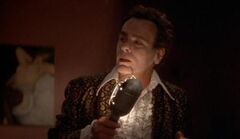Biography[]
Frederick Elmes, A.S.C., was born in New Jersey in 1946. His father gave him his Leica camera and ensued Elmes' interest in photography. He studied fine art photography at the Rochester Institute of Technology and The George Eastman House. He then pursued his passion for cinema earning a Masters in Fine Art from New York University where he studied under Beda Batka. In the early 1970s, he was offered a fellowship at the American Film Institute. There he met John Cassavetes and David Lynch, both of whom he collaborated with. Elmes is known for being Lynch's go-to cinematographer, and his many other collaborations with directors such as Ang Lee and Jim Jarmusch. Elmes is heavily influenced by Sven Nykvist, Ingmar Bergman's principal cinematographer.
David Lynch[]
Frederick Elmes met David Lynch while studying at AFI. He became the second principal cinematographer on Lynch's Eraserhead. He also was on 2nd Unit cinematography team for Dune, where he shot a lot of abstract filming of fire and flames. You can see similar images in his later work in Wild at Heart. Elmes and Lynch went on to work on two more features, Blue Velvet and Wild at Heart.
Eraserhead[]
A twenty page script turned into a five year production with two different cinematographers. The original cinematographer, Herbert Cardwell, died in his sleep and Frederick Elmes took over. The challenge in this transition was finding someone who was able to continue on and carry through Lynch’s original vision in a way that extended Cardwell’s work.
Eraserhead was shot on 35mm black and white, in a bit more traditional Hollywood style film compared to Lynch’s later work. The dreamy images are often contrasted with uncomfortable or awkward characters and their actions. It features high contrast and heavy shadows, with little to no details in the shadows. There are splashes of light staged in frame, to break up the foreground, midground and background elements, adding to Henry’s surrealist world.
These visuals emphasize the thought of something or someone lurking around in the shadows. The minimal details in the shadow cause the audience’s mind to wander and imagine what it there for themselves. As Lynch’s films often take on the subconscious and surrealism, Elmes is able to transfer these ideas visually through his treatment of chiaroscuro, specifically dark shadows with no detail.
Blue Velvet[]
Nomination for Best Cinematography by the Film Independent Spirit Awards.
Traditional three-point lighting is used for a majority of the film, with a mixture of low and high-key lighting. Elmes uses heavy shadows again. A memorable scene is Sandy emerging from the darkness on a deserted neighborhood street. We first hear Sandy’s question, “Are you the one who found the ear?” and then watch a black screen until her figure emerges from the shadows.
Shot in color but featured a gradual de-saturation of colors from start to finish. Transitioning from softer to harsher shadows as Jeffrey uncovers more of twisted nature of the residents, society and himself.
Wild at Heart[]
Won for Best Cinematography by the Film Independent Spirit Awards.
External links[]
- Frederick Elmes at Wikipedia
- Frederick Elmes at the Internet Movie Database






